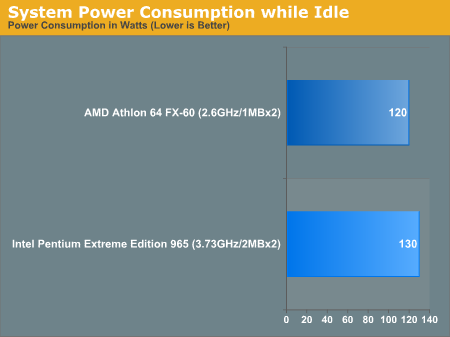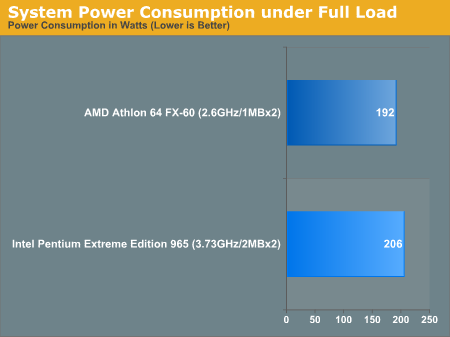With the heatspreader on top of the chip, you could hardly tell it apart from a Conroe. It looked and smelled like one, but that's where the similarities end. While the fastest Conroe based processors will barely exceed 3.0GHz, this chip is clocked at a mighty 3.73GHz. Indeed, what Intel had sent us was no Conroe. It was the new dual core Pentium Extreme Edition 965, a chip that's being announced today, but one that won't actually be shipping in retail systems until next month. And yes, it's another very high clocked, deeply pipelined CPU from Intel. It's not the power efficient, high performing, competitive part that we want from Intel; it's yet another bump in the rocky road of NetBurst.
Needless to say, it's not a chip that we were too excited about, especially after having our appetites whet by Conroe earlier this month. But the new Extreme Edition did manage to surprise us in a number of areas, some of which may surprise you as well. When we last looked at the Pentium Extreme Edition 955, we found its power consumption to be a bit troubling. The move to 65nm didn't seem to do much for the Pentium 4, as AMD was still able to maintain a significant advantage in power consumption. As it turns out, the initial 65nm parts from Intel did not support all of the power management features that were introduced in later versions of Intel's 90nm silicon. Mainly, support for EIST (Enhanced Intel SpeedStep Technology) and the new C1E enhanced halt state, both of which were introduced over a year ago initially with C1E on the 5xxJ series of processors and later adding EIST on the 6xx series of processors. For whatever reason, neither technology made its way into the Presler EE chips (65nm dual core Extreme Edition). With the new Extreme Edition 965, Intel re-added support for C1E, but EIST is still not supported (note that C1E support was added to later steppings of the EE 955, just not the initial stepping). The two technologies vary as follows (taken from our Pentium 4 6xx review):
C1E - Enhanced Halt State
"Whenever the OS executes the halt instruction, the CPU enters what is known as the halt state. Architecturally, what's going on in a halt state is the clock signal is shut off to the CPU for some period of time. With no clock signal, none of the logic in the chip will do anything and thus power consumption is reduced. Performance is also significantly reduced; however, the halt instruction isn't usually called during application usage, so the performance aspects of the halt state aren't very important.EIST:
The problem with the halt state is that it does nothing to reduce voltage, only current draw by stopping clocks from going to the CPU. Since Power varies linearly with both current and voltage (P = I * V), you're effectively only addressing half of the problem. The Enhanced Halt State, as Intel calls it, does two things: it reduces the clock speed of the CPU by decreasing the clock multiplier down to its minimum value (on the EE 965 series, that's 14x, or 2.8GHz), then reducing the voltage. The clock speed is reduced and then the voltage is dropped, to maintain stability.
Intel insists that the enhanced halt state is a significantly lower power state than the conventional halt state, thanks to the reduction in voltage in addition to the reduction in clock speed. While the standard halt state causes a linear reduction in power, Intel's enhanced halt state causes an exponential decrease in power, potentially offering better power savings than the standard halt state. The real world impact obviously depends on how idle your system happens to be."
"What EIST does is very similar to AMD's Cool'n'Quiet. It is demand based reduction in CPU clock speed and voltage. Using the same mechanism of adjusting clock speed and voltage, based on the application demand, the processor will dynamically increase/decrease its clock speed between its minimum clock and its normal operating frequency, as well as voltage, in order to optimize for power consumption.Because of the support for C1E and Intel's 65nm process, power consumption is finally competitive with AMD. Let's have a look at idle power consumption first:
Because of the way EIST (and AMD's Cool'n'Quiet) works, there's inherently a drop in performance. The idea is this: if you're performing a task that's not using 100% of the CPU, the CPU will operate at a slightly reduced frequency in order to conserve power. So, while some tasks will require that the system run at full speed, others will run at lower speeds. "

Also, keep in mind that AMD's Cool'n'Quiet is enabled, and the EE 965's C1E support is kicking in to keep its power consumption low at idle as well.
Under load, the comparison is also very close:

In our first look at Intel's Presler core with the Extreme Edition 955, we investigated the benefits of Hyper Threading with a dual core CPU as well as the performance impact of Presler over Smithfield. So, be sure to consult that article if you want a more in-depth look at Intel's 65nm dual core desktop CPU.